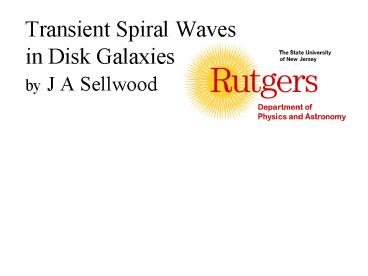Transient Spiral Waves in Disk Galaxies by J A Sellwood - PowerPoint PPT Presentation
1 / 19
Title:
Transient Spiral Waves in Disk Galaxies by J A Sellwood
Description:
Does it work the same way in nature? Mixture of evidence from real data and ... Toomre & Zang introduced central cutout and an outer taper in active density ... – PowerPoint PPT presentation
Number of Views:40
Avg rating:3.0/5.0
Title: Transient Spiral Waves in Disk Galaxies by J A Sellwood
1
Transient Spiral Wavesin Disk Galaxiesby J A
Sellwood
2
Sellwood Carlberg (1984)
3
Transient Spiral Wavesin Disk Galaxiesby J A
Sellwood
- Easy to observe in N-body simulations
- But what causes them?
- Does it work the same way in nature?
- Mixture of evidence from real data and simulations
4
Indirect evidence for transients
- Age-velocity dispersion relation
- Geneva-Copenhagen survey (Nordström et al 2004)
- scattering by GMCs inadequate (L84, L91)
- heating by transient spirals (CS86)
- hint of evolution in velocity ellipsoid shape
(IKM93)
5
Indirect evidence for transients
- Age-velocity dispersion relation
- Metallicity spread of stars in the solar
neighbourhood (EA93) - spirals cause radial mixing of stars (SB02)
- also must drive large-scale turbulence in gas
6
Indirect evidence for transients
- Age-velocity dispersion relation
- Metallicity spread of stars in the solar
neighbourhood - Importance of dissipation (gas)
- if spiral activity is to continue (SC84)
7
A linearly stable disk
- Mestel disk ? ? 1/r, Vc const
- Toomre Zang introduced central cutout and an
outer taper in active density - both replaced by rigid mass
- Carried through a global stability analysis of
warm disks with a smooth DF - confirmed by N-body simulation (SE01)
- Halve the active mass, in order to suppress a
lop-sided instability, and set Q1.5 - They proved this disk is globally stable
8
Simulations of the ½-mass Mestel disk
- m2 spiral analysis
- upper tight leading
- lower tight trailing
- 50K ? N ? 500M
- No steady rise for the largest N
- confirms stability
- Otherwise saturation amplitude is independent of
N - Characteristic of true instabilities
- Non-linear feedback?
9
No single coherent wave
- Several separate frequencies as the amplitude
rises i.e. not a single mode
10
Groove modes
- Any sharp feature in the DF is destabilizing
- Groove yields a vigorous mode (SK91)
- enthusiastic support from the surrounding disk
- Amplitude limited by onset of horseshoe orbits at
corotation (SB02)
11
Angular Momentumand Resonances
- Lindblad diagram for a logarithmic potential
- slope of all vectors ?p
- Wave action absorbed at LRs ? scattering
- Lines show loci of resonances for eccentric orbits
12
Pick out one wave
- Coherent frequency for significant time
- Best fit shape
- peak near corotation
- extends to LRs
- But it decays
- CR peak disperses
- wave action drains to LRs
13
Scattering at ILR
- Particle distribution after wave decays
- No free parameters!
- solid lines are LRs
- dashed lines scattering trajectories
- Large Erand because ILR particles stay on
resonance
14
Recurrent cycle?
- Each coherent wave leaves behind a damaged DF
- Apparently creating the conditions for a new
instability - Exactly how this works is still unclear
- maybe just a horrible artifact of the
simulations! - Can I find evidence that anything similar occurs
in nature?
15
Geneva-Copenhagen survey(Nordström et al. 2004)
- Known distances, full space motions and ages of
13,240 local F G dwarfs
- DF not at all smooth (DB98)
- Not dissolved clusters (FP06)
- Hard to interpret the structure in velocity space
16
Project into integral space
- Scaled by R0 and V0 assuming a locally flat RC
- Lower boundary selection effect
- L-R bias asymmetric drift
- Look at features
- adjust ?p ? slide L-R
- Scattering or trapping?
scattering trajectories dot-dash LRs dotted
CR dashed
17
Bootstrap analysis
- Assuming scattering at
- ILR (above) real data are highly significant
(confidence gtgt 99) at one frequency - or OLR (below) nothing really credible
- But it could also be trapping at any resonance
18
Phases of these stars
- Action-angle variables
- radius shows ?( 2 ? radial action)
- azimuth is 2w? wr
- Concentration of stars at one phase
- No other simple combination of phases does this
- Exactly the stars (red) I identified before
19
Implications
- Evidence for an ILR is strong
- What the heck is an inner LR doing out here?
(AT) notwithstanding! - Support for the picture I have been developing
from the simulations - spirals are transient
- decay of one pattern seeds the growth of another
- each is true instability of a non-smooth DF
- Needs more work
20
Conclusions
- Simulations display recurrent transient spirals
- result may even be right!
- each wave is a true instability of a non-smooth
DF - mechanism for recurrence yet to be understood
- gravitationally driven turbulence
- Seems to be what is going on in solar
neighbourhood and perhaps elsewhere - strong evidence for a recent ILR in the local
Geneva-Copenhagen survey data - three strands of supporting evidence for
transients































